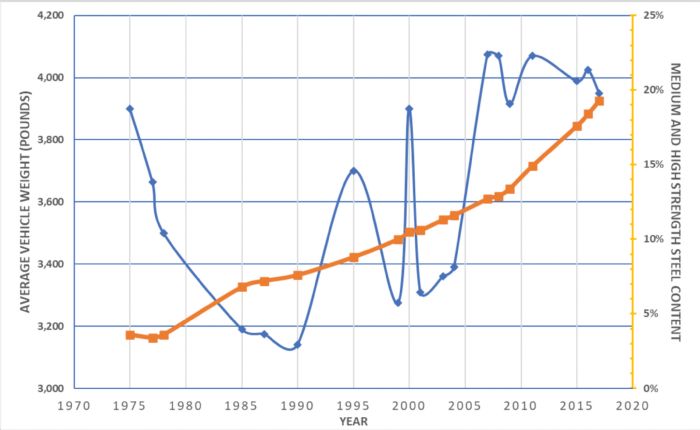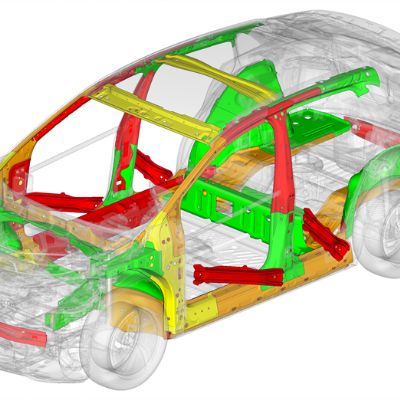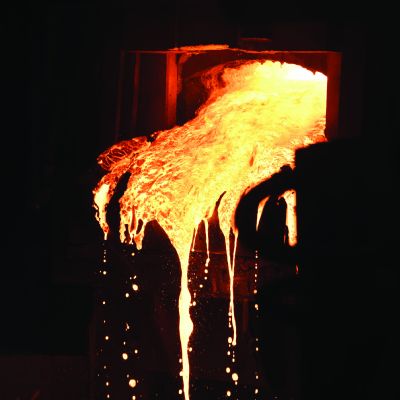HSLA Chemistry
Like all steels, HSLA steels primarily consist of iron. Typical alloying additions for solid-solution strengthening include as much as 2-percent manganese and smaller amounts of chromium, silicon, nickel, molybdenum, copper and nitrogen.
HSLA steels also include microalloying additions of vanadium, niobium and titanium, used individually (typically less than 0.1 percent by weight) or combined (typically less than 0.2 percent by weight). These microalloying additions form carbides, nitrides or carbo-nitrides responsible for precipitation strengthening and grain refinement, leading to improvements in strength and toughness.
HSLA steels typically contain 0.05- to 0.2-percent carbon. Lower carbon content and lower alloying content lead to increased ductility, toughness and weldability compared to grades achieving their strength from only solid-solution strengthening, such as C-Mn steels, or from alloying, such as chromoly (AISI/SAE 4130). Lower alloying and elimination of post-forming heat treatment makes HSLA steels economical for many applications.
In the mid-1970s, General Motors Research modified existing SAE grades to produce 2-mm-thick hot-rolled steels with these approximate properties: 600-MPa yield strength, 700-MPa tensile strength and 17-percent total elongation. After annealing and cold rolling to 1 mm, the properties changed to 460-MPa yield, 615-MPa tensile and 23-percent elongation. Significantly, the parameter most related to sheet formability, n-value, improved to 0.24, comparable to the n-value of mild steel with half of the yield strength. GM conducted forming and fatigue trials of these grades in wheel-rim and disc applications and found that GM 980X was a viable substitute for plain-carbon steel in these applications and could result in weight savings to as much as 25 percent. Other applications under consideration included control arms, bumper face bars and bumper reinforcements. While GM did not intend to market these grades, its work spurred additional research and investment.
The engineered microstructures and favorable properties of these grades come from controlled thermal and mechanical processing at the steel mill. Seeing the potential market, steelmakers invested in the technology needed to achieve the critical heating and cooling rates required for these products. Another investment made by steelmakers: improved analytical techniques, including the transmission electron microscope (TEM), which helped researchers better understand the interaction between mill process conditions, alloy content and resulting steel properties. TEMs required highly skilled operators along with knowledgeable engineers to interpret the results, and came with a significant purchase price. Today’s basic models cost around $100,000, but with additions, modifications and upgrades, the price can increase ten-fold.
The 1980s saw the commercialization of HSLA steels, available today with yield strengths exceeding 700 MPa.
Bake-Hardenable Steels
Bake-hardenable (BH) steel grades exhibit an increase in yield strength after room-temperature stamping followed by processing through a thermal cycle comparable to the time-temperature profile used in automotive paint curing (or baking)—approximately 170 C for 20 min. These grades have yield strength at shipment from the steel mills of 180 to 300 MPa and work harden approximately 30 MPa with the introduction of 2-percent strain, either from stamping or during a tensile test. After forming, the paint-bake cycle results in an additional yield-strength increase of 20 to 35 MPa.
These grades find applications in body panels, hoods and door skins. Solid-solution hardening elements such as phosphorus, manganese and silicon help achieve the desired initial strength. A specifically engineered amount of carbon remaining in solid solution, on the order of 25 parts/million, results in the additional yield-strength increase through controlled carbon aging during the paint-bake thermal cycle. This increases the yield strength of formed parts for increased dent resistance. Formability does not suffer, since the strength increase occurs after stamping.
Initial production of these cold-rolled steels in the 1980s typically did not include a galvanized coating, or were room-temperature electrogalvanized at the steel mill. Hot-dip galvanized (or galvannealed) BH steels require a different starting composition and mill-production approach, since the hot-dip process itself is a thermal cycle. Achieving the required composition and thermal-cycle control required significant process control and equipment upgrades to get the desired bake hardenability while avoiding undesirable aging effects. Commercialization of BH steels with hot-dip coatings occurred during the mid-’90s, with new capacity coming as companies allocated the required capital expenditures.
Clean (XF) Steels
Sulfide inclusions cause toughness issues in rolled steel products. High manganese content, such as that found in higher-strength steels, worsens the problem. Avoiding these inclusions requires lowering sulfur levels in the steel melt and further removing sulfur in ladle-treatment facilities.
Inclusion shape-controlled microalloyed HSLA grades (dubbed XF steels) were first used during the 1970s. Among other benefits, adding controlled amounts of elements such as calcium to the melt prevented the formation of long manganese sulfide stringers responsible for reduced toughness and ductility, especially perpendicular to the rolling direction. MF
Industry-Related Terms: Alloys,
Carburizing,
Ductility,
Form,
Forming,
Hardenability,
Inclusions,
Nitriding,
Surface,
Tensile Strength,
WeldabilityView Glossary of Metalforming Terms
See also: Engineering Quality Solutions, Inc., 4M Partners, LLC
Technologies: Materials
 In most engineered applications, however, strength is not the only important parameter. For example, structural steels also are known as carbon-manganese (C-Mn) steels, since strength primarily comes from these two alloying elements. Adding additional carbon or manganese continues to increase strength, but above a certain level the steel experiences a significant reduction in ductility, formability and weldability. Adding other elements such as chromium, molybdenum and silicon also increases strength, but will create the same challenges as C-Mn steels with higher cost. Typically, these limitations restrict the yield strength of these grades to no more than approximately 280 MPa.
In most engineered applications, however, strength is not the only important parameter. For example, structural steels also are known as carbon-manganese (C-Mn) steels, since strength primarily comes from these two alloying elements. Adding additional carbon or manganese continues to increase strength, but above a certain level the steel experiences a significant reduction in ductility, formability and weldability. Adding other elements such as chromium, molybdenum and silicon also increases strength, but will create the same challenges as C-Mn steels with higher cost. Typically, these limitations restrict the yield strength of these grades to no more than approximately 280 MPa.







 Webinar
Webinar
